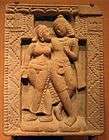Ramagupta
| Ramagupta | |
|---|---|
| 5th Gupta Emperor | |
| Predecessor | Samudragupta |
| Successor | Chandragupta II |
| Gupta Empire 320 CE–550 CE | ||||||||||||||||||||||||||||||||||
|---|---|---|---|---|---|---|---|---|---|---|---|---|---|---|---|---|---|---|---|---|---|---|---|---|---|---|---|---|---|---|---|---|---|---|
|
||||||||||||||||||||||||||||||||||
Ramagupta was the elder son and immediate successor of Samudragupta and succeeded by his younger brother Chandragupta II. Initially, he was known from the traditional narratives only. But later, three inscriptions on Jaina tirthankara images were discovered from Durjanpur near Vidisha, which mention him as the Maharajadhiraja. A large number of his copper coins also have been discovered from Eran-Vidisha region.[1]
Ramagupta in tradition
भगवतोर्हतः चन्द्रप्रभस्य प्रतिमेऽयं कारिता महाराजाधिराज-श्री-रामगुप्तेन उपदेशात् पाणिपात्रिक-चन्द्रक्षमाचार्य्य-क्षमण-श्रमण-प्रशिष्य-आचार्य्य सर्प्पसेन-क्षमण-शिष्यस्य गोलक्यान्त्या-सत्पुत्रस्य चेलु-क्षमणस्येति
The Ramagupta Inscription found near Vidisha 375 CE
The modern scholars first became aware about the traditional accounts on Ramagupta, in 1923, when Sylvain Levi published some extracts of a Sanskrit play, named Devichandragupta, now lost, from Natyadarpana, which contains six quotations from this text. Natyadarpana is a Sanskrit work on dramaturgy, written by two Jaina writers, Ramachandra and Gunachandra. In the same year, R. Saraswati also found three passages of Devichandragupta, quoted by Bhoja in his Shringaraprakasha and Sarasvatikanthabharana. In 1924, Rakhaldas Banerjee supplemented it by the information found from a verse of the Sanjan copper plate inscription of Amoghavarsha I dated 1924 and a brief remark made by Banabhatta in his Harshacharita, which was illucidated by the commentator Shankararya.[1]
A.S. Altekar, on the basis of the evidences from the fragments of the Devichandragupta, copper plate inscriptions of Rashtrakuta kings Amoghavarsha I and Govinda IV from Sanjan, Khambhat and Sangli, brief reference of Banabhatta, a stray verse quoted by Rajashekhara in his Kavyamimamsa and the narrative of Rawwal and Barkamaris found in a Persian text, Mujmal-ut-Tawarikh (which is a translation of an Arabic work by Abu-al Hasan Ali, which in turn is a translation of an unknown Sanskrit work), concluded that Ramagupta mentioned in the traditional accounts really existed.[1]
According to Natya-darpana, Ramgupta was a coward. He married the woman, Dhruvaswamini by force who was engaged with his brother Chandragupta II. He also became the King of the Gupta empire, though his brother was declared as the future King of the Gupta empire after Samudragupta's death. According to traditional accounts, Ramagupta decided to expand his kingdom by attacking the Sakas in Gujarat. The campaign soon took a turn for the worse and the Gupta army was trapped. The Saka king, Rudrasimha III, demanded that Ramagupta hand over his wife Dhruvswamini in exchange for peace. The weak king was inclined to accept these terms, to the outrage of his wife and his brother Chandragupta. Using subterfuge, Chandragupta went to the Saka camp, killed the Saka king and won the victory and also the esteem of the people and the queen. A short while later, Ramagupta was deposed and killed by his brother, who became Chandragupta II. Chandragupta II also married his erstwhile sister-in-law, Dhruvswamini.
This tale has parallels to the story of Rani Padmini of Chittor and the subterfuge she used to free her husband. Dhruvadevi was the chief queen of Chandragupta II and the mother of his heir Kumara Gupta I. Chandragupta II also claimed the conquest of the Saka kingdom. What part the shadowy figure of Ramagupta played in these stories is unclear.
Ramagupta in Devichandragupta
In the play Devichandragupta by Vishakhadatta, Ramagupta is portrayed as a weak and impotent king, afraid and incapable of warfare. The play holds that Ramagupta usurped the right to the throne of his younger brother Chandragupta II and also married his betrothed Dhruvasvamini by force.
Notes
| Regnal titles | ||
|---|---|---|
| Preceded by Samudragupta |
Gupta Emperor | Succeeded by Chandragupta II |

